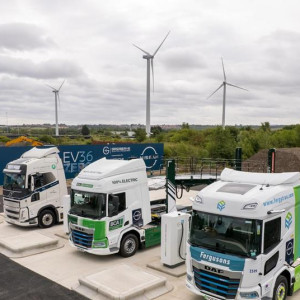ZEHID check-in: over 80 clean trucks and 10+ sites delivered


The UK's GBP200m Zero Emission HGV and Infrastructure Demonstrator (ZEHID) programme has now passed the halfway mark of its initial build phase. More than 80 zero-emission lorries have been delivered alongside over ten infrastructure sites, and commissioning work is accelerating. Vehicles are already in service across several fleets, but large-scale data collection across the full programme will only begin in 2026.
ZEHID was launched in 2022 to accelerate the shift to zero-emission road freight through the collaboration of four consortia: Electric Freightway, eFREIGHT 2030, ZEN Freight and HyHAUL. The programme operates in two distinct stages, beginning with procurement and infrastructure development from 2024 to 2026, which will then transition into systematic on-road monitoring from 2026 to 2031. All vehicles and infrastructure funded under ZEHID are scheduled to be operational by March 2026, marking the commencement of structured data collection.
As Simon Buckley, knowledge transfer manager at Innovate UK explained to us, more than 300 zero-emission HGVs have been ordered across the consortia, with over 80 delivered by September 2025. These vehicles have already logged hundreds of thousands of kilometres, much of it in commissioning and driver training, but increasingly in commercial service. Battery-electric lorries are recording ranges of 290-490km (180-300 miles) per charge in early operations, while hydrogen vehicles are projected to achieve 400-850km (250-530 miles) once they are deployed at scale.
Operators are already integrating the HGVs into their fleets:
- ? A.F. Blakemore & Son has used electric HGVs for Spar distribution since May 2024.
- ?
Samworth Brothers Supply Chain has operated Volvo FM Electrics from Leicester since June 2024, including a 623-mile round trip to Scotland with a solar-powered refrigerated trailer.
- ? Boughey Distribution has introduced electric lorries in Newcastle-under-Lyme, while United Utilities is using four Volvo FM Electrics with tipper trailers in the northwest.
- ? At Nissan's Sunderland plant, a GBP1.4m high-power charging station has been opened to support a fleet of 25 electric trucks operated with partners Fergusons, Yusen and BCA, covering more than 2.4 million kilometres a year.
- ?
Larger fleets such as Amazon, Royal Mail, Wincanton and GXO have vehicles scheduled for delivery through 2025.
Monitoring data shows that ZEHID battery-electric HGVs are currently running at lower average speeds (33.6 km/h) compared with diesel comparators (50.4 km/h). This reflects how the vehicles are being deployed, with BEVs used more on urban routes and in training, rather than motorway trunking. Infrastructure installation is less visible but is now ramping up.
The target remains 60-70 charging and refuelling sites by March 2026. Innovate UK says more than ten sites have already been commissioned, with a long list of additional locations due to go live during the current quarter. "A lot of the work has been undertaken and we are starting to see the fruits of the project's labour -- but it is not as discrete as with vehicle delivery," said Buckley. "A long list of sites is getting commissioned this quarter, alongside launch days."
Grid connections have been a challenging area, with capacity and timing critical to site delivery. "One of the lessons learned is around the grid connection process: the timing, the costs, how it works in practice. That's been a big challenge for many projects," Buckley acknowledged. "But many of these issues have now been overcome and the programme remains on track to deliver the charge points in phase one of ZEHID." The Energy Networks Association has published guidance and online tools to help operators check local grid headroom through DNO heatmaps, while the eHGV Charger Connections Guide sets out practical steps on connection agreements and site planning.
For consortia members, ZEHID provides vehicles and depot infrastructure with government support covering up to 80% of capital costs, though grants cannot reduce the total cost of ownership below diesel parity, leaving operators to cover a significant share. For smaller hauliers outside the main projects, options are more limited. Some consortia offer associate membership schemes, and Innovate UK has said that selected depot sites will be bookable by appointment once operational.
"The intention is that some depot infrastructure should be bookable by appointment," Buckley confirmed. "That's still being worked out in practice, but the idea is to make it usable by a wider range of operators." A separate GBP30m Depot Charging Scheme was launched in July 2025 to support depot installations for HGVs, vans and coaches. Applications are open until 28 November 2025.
Information on real-world costs is not yet available.
Innovate UK has confirmed that cost and total cost of ownership analysis will be published in annual public reports during the monitoring phase, once the procurement stage has concluded and more operational data is available.
"You can't fund every truck in the UK with GBP200m, but you can stimulate the market," Buckley said. "Already we've seen private investment coming alongside ZEHID, and that's the point, to get the ball rolling."